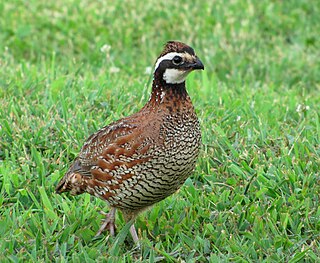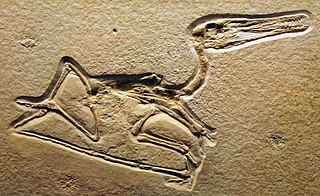Related Research Articles

Anseriformes is an order of birds that comprise about 180 living species in three families: Anhimidae, Anseranatidae, and Anatidae, the largest family, which includes over 170 species of waterfowl, among them the ducks, geese, and swans. Most modern species in the order are highly adapted for an aquatic existence at the water surface. With the exception of screamers, all have phalli, a trait that has been lost in the Neoaves. Due to their aquatic nature, most species are web-footed.

Requiem sharks are sharks of the family Carcharhinidae in the order Carcharhiniformes. They are migratory, live-bearing sharks of warm seas and includes such species as the tiger shark, the spinner shark, the blacknose shark, the blacktip shark, the grey reef shark, the blacktip reef shark, and the Oceanic whitetip shark.

The New World quails or Odontophoridae are small birds only distantly related to the Old World quail, but named for their similar appearance and habits. The American species are in their own family Odontophoridae, whereas Old World quail are in the pheasant family Phasianidae. The family ranges from Canada through to southern Brazil, and two species, the California quail and the bobwhite quail, have been successfully introduced to New Zealand. The stone partridge and Nahan's partridge, both found in Africa, seem to belong to the family. Species are found across a variety of habitats from tropical rainforest to deserts, although few species are capable of surviving at very low temperatures. Thirty-four species are placed in ten genera.

Bronchocela is a genus of Asian lizards in the family Agamidae.

Franz Julius Ferdinand Meyen was a Prussian physician and botanist.

Adam Afzelius was a Swedish botanist and an apostle of Carl Linnaeus. Afzelius was born at Larv in Västergötland in 1750. He was appointed teacher of oriental languages at Uppsala University in 1777, and in 1785 demonstrator of botany. In 1793 he was elected a member of the Royal Swedish Academy of Sciences. In 1800, Adam Afzelius became member of the German Academy of Sciences Leopoldina.

Plateosaurus is a genus of plateosaurid dinosaur that lived during the Late Triassic period, around 214 to 204 million years ago, in what is now Central and Northern Europe and Greenland, North America. Plateosaurus is a basal (early) sauropodomorph dinosaur, a so-called "prosauropod". As of 2011, two species are recognised: the type species P. engelhardti from the late Norian and Rhaetian, and the slightly earlier P. gracilis from the lower Norian. However, others have been assigned in the past, and there is no broad consensus on the species taxonomy of plateosaurid dinosaurs. Similarly, there are a plethora of synonyms at the genus level.

Liliensternus is an extinct genus of basal Neotheropod dinosaur that lived approximately 210 million years ago during the latter part of the Triassic Period in what is now Germany. Liliensternus was a moderate-sized, bipedal, ground-dwelling carnivore, that could grow up to 5.15 m (16.9 ft) long. It is the best represented Triassic theropod from Europe and one of the largest known.
The genus Eligmodontia consists of five or six species of South American sigmodontine mice restricted to Bolivia, Chile, and Argentina. Species of Eligmodontia occur along the eastern side of the Andes Mountains, in Patagonia, and in the Chaco thorn forest of South America. They can be found in arid and semiarid habitats and in both high and low elevation areas. These rodents are commonly known as gerbil mice or by their local name lauchas. Sometimes they are also called silky desert mice, highland desert mice or silky-footed mice. The closest living relatives are probably the chaco mice (Andalgalomys), the leaf-eared mice, and Salinomys.

Diopecephalus is a genus of pterodactyloid pterosaur from the Lower Tithonian of the Lithographic Limestone, Bavaria, Germany. The type and only species is D. kochi, although the name has been applied to Pterodactylus longicollum, with longicollum erroneously listed as the type species.

Altmuehlopterus is a genus of pterosaur, belonging to the Pterodactyloidea. It lived in the Late Jurassic of what is now Germany. It was formerly known as "Daitingopterus", a nomen nudum, informally coined in 2004.

Chaetomium is a genus of fungi in the Chaetomiaceae family. It is a dematiaceous (dark-walled) mold normally found in soil, air, cellulose and plant debris. According to the Dictionary of the Fungi, there are about 95 species in the widespread genus.

Oxychilus is a genus of small air-breathing land snails, terrestrial pulmonate gastropods in the family Oxychilidae, the glass snails.

Urolophus is a genus of round rays mostly native to the western Pacific Ocean and the Indian Ocean, though one species occurs in the Pacific waters of the Mexican coast. Müller and Henle erected Urolophus in an 1837 issue of Bericht Akademie der Wissenschaften zu Berlin. The name is derived from the Greek oura, meaning "tail", and lophos, meaning "crest". In Urolophus, the outer rims of the nostrils are not enlarged into lobes, but may form a small knob at the back.

Euspira is a genus of medium-sized sea snails, marine gastropod molluscs in the family Naticidae, the moon snails.

Dicerca is a genus of beetles in the family Buprestidae, containing the following species:

Cochylidia richteriana is a moth of the family Tortricidae. It was described by Josef Emanuel Fischer von Röslerstamm in 1837. It is found from central and northern Europe to Mongolia, China, the Russian Far East, Korea and Japan.

Heinrich Conrad Weinkauff (1817–1886) was a German zoologist and malacologist. Weinkauff described many new species.

Eunotia is a genus of diatoms. They are fresh water diatoms, specifically common in lakes, and they are also common in fossil records, although their siliceous wall design may have been lost and they appear plane, an example is Eunotia tetradon.
References
- ↑ Fischer, Friedrich Ernst Ludwig von & Meyer, Carl Anton von. 1837. Index Seminum, quae Hortus Botanicus Imperialis Petropolitanus pro Mutua Commutatione Offert. Accedunt Animadversiones Botanicae Nonnullae. St. Petersburg 3: 30
- ↑ Tropicos, Amblyocarpum Fisch. & C.A. Mey.
- ↑ Flann, C (ed) 2009+ Global Compositae Checklist
| This Asteroideae article is a stub. You can help Wikipedia by expanding it. |